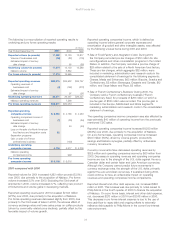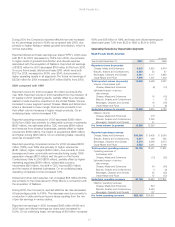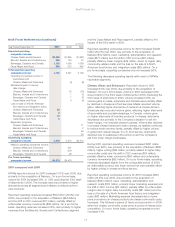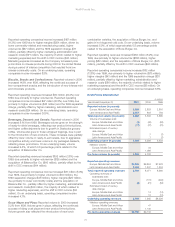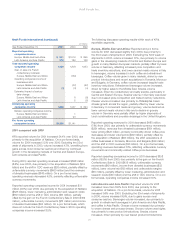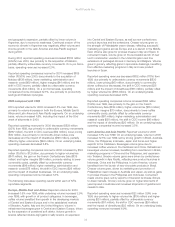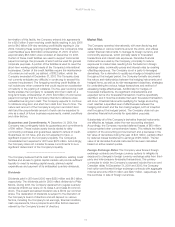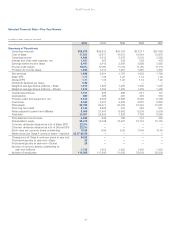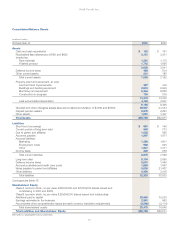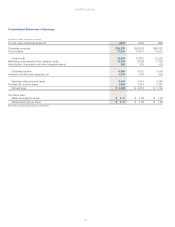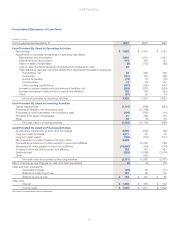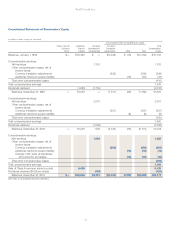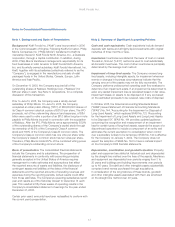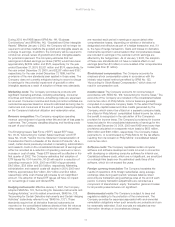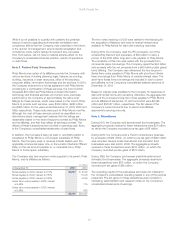Kraft 2001 Annual Report Download - page 42
Download and view the complete annual report
Please find page 42 of the 2001 Kraft annual report below. You can navigate through the pages in the report by either clicking on the pages listed below, or by using the keyword search tool below to find specific information within the annual report.
Kraft Foods Inc.
36
This VAR computation is a risk analysis tool designed to statistically
estimate the maximum probable daily loss from adverse movements
in interest rates, foreign currency rates and commodity prices
under normal market conditions. The computation does not purport
to represent actual losses in fair value or earnings to be incurred
by the Company, nor does it consider the effect of favorable
changes in market rates. The Company cannot predict actual future
movements in such market rates and does not present these VAR
results to be indicative of future movements in such market rates
or to be representative of any actual impact that future changes
in market rates may have on its future results of operations or
financial position.
New Accounting Standards
Effective January 1, 2001, the Company adopted Statement of
Financial Accounting Standards (“SFAS”) No. 133, “Accounting for
Derivative Instruments and Hedging Activities,” and its related
amendment, SFAS No. 138, “Accounting for Certain Derivative
Instruments and Certain Hedging Activities” (collectively referred
to as “SFAS No. 133”). These standards require that all derivative
financial instruments be recorded on the consolidated balance
sheets at their fair value as either assets or liabilities. Changes in
the fair value of derivatives are recorded each period in earnings or
accumulated other comprehensive losses, depending on whether
a derivative is designated and effective as part of a hedge
transaction and, if it is, the type of hedge transaction. Gains and
losses on derivative instruments reported in accumulated other
comprehensive losses are included in earnings in the periods in
which earnings are affected by the hedged item. As of January 1,
2001, the adoption of these new standards did not have a material
effect on net earnings (less than $1 million) or accumulated other
comprehensive losses (less than $1 million).
The Emerging Issues Task Force (“EITF”) issued EITF Issue
No. 00-14, “Accounting for Certain Sales Incentives” and EITF
Issue No. 00-25, “Vendor Income Statement Characterization of
Consideration Paid to a Reseller of the Vendor’s Products.” As a
result, certain items previously included in marketing, administration
and research costs on the consolidated statement of earnings will
either be recorded as a reduction of operating revenues or as an
increase in cost of sales. These EITF Issues will be effective in the
first quarter of 2002. The Company estimates that adoption of
EITF Issues No. 00-14 and No. 00-25 will result in a reduction of
operating revenues in 2001, 2000 and 1999 of approximately
$4.6 billion, $3.6 billion and $3.4 billion, respectively. Marketing,
administration and research costs will decline in 2001, 2000 and
1999 by approximately $4.7 billion, $3.7 billion and $3.4 billion,
respectively, while cost of sales will increase by an insignificant
amount. The adoption of these EITF Issues will have no impact
on net earnings or basic and diluted EPS.
During 2001, the Financial Accounting Standards Board (“FASB”)
issued SFAS No. 141, “Business Combinations” and SFAS No. 142,
“Goodwill and Other Intangible Assets.” Effective January 1, 2002,
the Company will no longer be required to amortize indefinite life
goodwill and intangible assets as a charge to earnings. In addition,
the Company will be required to conduct an annual review of
goodwill and other intangible assets for potential impairment. The
Company estimates that net earnings and diluted earnings per
share would have been approximately $2,839 million and $1.76,
respectively, for the year ended December 31, 2001; $2,531 million
and $1.74, respectively, for the year ended December 31, 2000; and
$2,287 million and $1.57, respectively, for the year ended December
31, 1999, had the provisions of the new standards been applied in
those years. The Company does not currently anticipate having
to record a charge to earnings for the potential impairment of
goodwill or other intangible assets as a result of adoption of these
new standards.
In October 2001, the FASB issued SFAS No. 144, “Accounting for
the Impairment or Disposal of Long-Lived Assets,” which replaces
SFAS No. 121, “Accounting for the Impairment of Long-Lived Assets
and Long-Lived Assets to be Disposed Of.” SFAS No. 144 provides
updated guidance concerning the recognition and measurement of
an impairment loss for certain types of long-lived assets, expands
the scope of a discontinued operation to include a component of
an entity and eliminates the current exemption to consolidation
when control over a subsidiary is likely to be temporary. SFAS
No. 144 is effective for the Company on January 1, 2002. The
Company does not expect the adoption of SFAS No. 144 to have
a material impact on the Company’s 2002 financial statements.
Contingencies
See Note 17 to the consolidated financial statements for a
discussion of contingencies.


